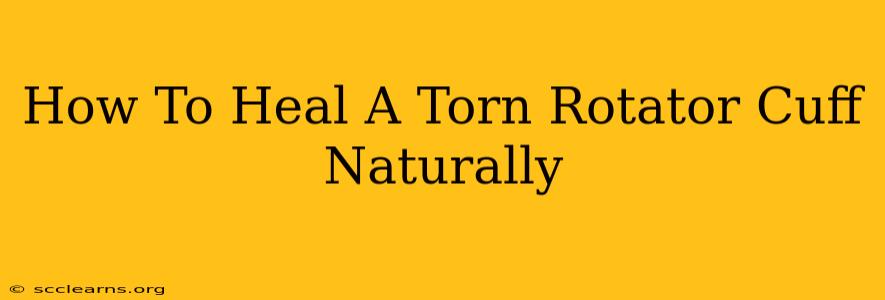A torn rotator cuff is a painful and debilitating injury that affects the shoulder joint. While surgery is often considered, many people seek natural ways to heal and manage the condition. This comprehensive guide explores natural methods to aid in rotator cuff recovery, emphasizing the importance of consulting a healthcare professional for proper diagnosis and treatment planning.
Understanding the Rotator Cuff
Before diving into natural healing methods, it's crucial to understand what the rotator cuff is and how it's injured. The rotator cuff is a group of four muscles and their tendons that surround the shoulder joint, providing stability and enabling a wide range of motion. A tear can occur from a sudden injury, like a fall or impact, or develop gradually due to overuse or repetitive motions.
Symptoms of a torn rotator cuff can include:
- Sharp pain: Especially with movement or at night.
- Weakness: Difficulty lifting or rotating the arm.
- Limited range of motion: Inability to fully raise or rotate the arm.
- Clicking or popping: Sounds emanating from the shoulder joint during movement.
- Swelling: Inflammation around the shoulder.
Natural Ways to Heal a Torn Rotator Cuff
It's important to note that natural methods are supportive therapies and should complement, not replace, professional medical advice. Always consult your doctor or physical therapist before starting any new treatment plan.
1. RICE Protocol: The Foundation of Natural Healing
The RICE protocol is a cornerstone of initial treatment for many musculoskeletal injuries, including a torn rotator cuff. It stands for:
- Rest: Avoid activities that aggravate the pain. This means limiting shoulder movement and avoiding strenuous activities.
- Ice: Apply ice packs to the affected area for 15-20 minutes at a time, several times a day. This helps reduce inflammation and pain.
- Compression: Use a compression bandage to support the shoulder and minimize swelling.
- Elevation: Keep your arm elevated above your heart whenever possible to reduce swelling.
2. Physical Therapy: Regaining Strength and Mobility
Physical therapy plays a critical role in the natural healing process of a torn rotator cuff. A physical therapist can design a customized program focusing on:
- Gentle range-of-motion exercises: Gradually increasing the flexibility and mobility of the shoulder joint.
- Strengthening exercises: Building strength in the rotator cuff muscles and surrounding muscles to support the shoulder.
- Postural correction: Addressing any posture issues that may contribute to shoulder pain and instability.
3. Anti-Inflammatory Diet: Reducing Inflammation Naturally
Diet significantly impacts inflammation levels in the body. An anti-inflammatory diet rich in:
- Fruits and vegetables: Packed with antioxidants and vitamins.
- Omega-3 fatty acids: Found in fatty fish, flaxseeds, and walnuts.
- Turmeric: A potent anti-inflammatory spice.
- Ginger: Another spice with anti-inflammatory properties.
Can help reduce pain and inflammation associated with a torn rotator cuff. Avoid processed foods, sugary drinks, and saturated fats, as they can worsen inflammation.
4. Alternative Therapies: Exploring Complementary Options
Some people find relief from complementary therapies such as:
- Acupuncture: Stimulating specific points on the body to reduce pain and improve circulation.
- Massage therapy: Relieving muscle tension and improving blood flow to the shoulder.
- Yoga and Pilates: Gentle exercises that improve flexibility, strength, and posture.
Important Note: These therapies should be considered alongside, not as a replacement for, medical advice and physical therapy.
5. Pain Management: Natural Pain Relief Options
Managing pain is crucial for facilitating the healing process. Natural pain relief options include:
- Over-the-counter pain relievers: Ibuprofen or naproxen can help reduce pain and inflammation. Always follow the recommended dosage.
- Heat therapy: Applying heat after the initial inflammation subsides can help relax muscles and relieve stiffness.
- Mindfulness and meditation: Stress reduction techniques can help manage pain and improve overall well-being.
When to See a Doctor
While natural methods can be beneficial, a torn rotator cuff requires proper medical evaluation. Seek immediate medical attention if:
- You experience severe pain or inability to move your arm.
- You have a significant deformity in your shoulder.
- You suspect a fracture or dislocation.
- Your symptoms don't improve after several weeks of home treatment.
Conclusion: A Holistic Approach to Rotator Cuff Healing
Healing a torn rotator cuff naturally requires a holistic approach combining rest, physical therapy, a healthy diet, and potentially complementary therapies. Remember that patience and consistency are key to successful recovery. By working closely with your healthcare provider and following a comprehensive treatment plan, you can improve your chances of achieving lasting relief and regaining full shoulder function. Always prioritize professional medical guidance throughout the healing journey.

